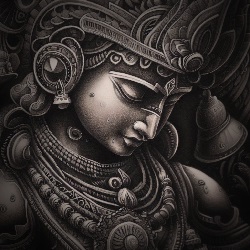 Hinduism, recognized as the world's oldest major religion, encompasses a rich and diverse set of beliefs, rituals, and practices that continue to shape the lives of approximately 1.2 billion adherents, accounting for around 15% of the global population. As a way of life, it profoundly influences the cultural, social, and spiritual aspects of its followers, particularly in India, where over 94% of the world's Hindu population resides. Unlike many other religions, Hinduism lacks a single founder or specific moment of origin. Instead, it has evolved over thousands of years, incorporating various philosophical and religious traditions, from the ancient Vedic period (circa 1500 - 500 BCE) to the present day.
Hinduism, recognized as the world's oldest major religion, encompasses a rich and diverse set of beliefs, rituals, and practices that continue to shape the lives of approximately 1.2 billion adherents, accounting for around 15% of the global population. As a way of life, it profoundly influences the cultural, social, and spiritual aspects of its followers, particularly in India, where over 94% of the world's Hindu population resides. Unlike many other religions, Hinduism lacks a single founder or specific moment of origin. Instead, it has evolved over thousands of years, incorporating various philosophical and religious traditions, from the ancient Vedic period (circa 1500 - 500 BCE) to the present day.
The vast geographical spread and historical depth of Hinduism have led to the development of diverse regional practices, sects, and philosophies, with four primary denominations: Shaivism, Vaishnavism, Shaktism, and Smartism. As a result, the faith demonstrates remarkable flexibility, allowing followers to adapt its teachings and rituals to their individual beliefs and lifestyles.
This essay will explore the process of becoming a Hindu by delving into the core beliefs and practices of the faith, such as the concept of Dharma, the four aims of life (Purusharthas), and the sacred texts that guide its followers. Furthermore, the essay will offer guidance on embracing Hinduism as a spiritual path, from acknowledging the multitude of gods and goddesses to participating in rituals and celebrations that foster a sense of belonging to this ancient and diverse tradition. Through this exploration, individuals seeking to understand and adopt Hinduism will gain insights into the rich tapestry of beliefs and practices that have nurtured the spiritual lives of millions of people for millennia.
Understanding Hinduism
Hinduism is a complex and multifaceted faith, often described as a way of life rather than a religion with rigid doctrines. To become a Hindu, one must first understand the core beliefs and philosophies that underpin the faith.
The Concept of Dharma
Dharma is a central concept in Hinduism, encompassing a wide range of ideas, including duty, morality, righteousness, and law. It serves as a guiding principle that helps individuals achieve spiritual growth, maintain social harmony, and find their unique purpose in life. The word "dharma" is derived from the Sanskrit root "dhri," which means to uphold or sustain. This etymology highlights the role of dharma in sustaining the moral and ethical order of the universe, as well as the social and cosmic order.
Dharma can be understood at various levels, each with its own implications and responsibilities:
Personal Dharma (Svadharma): Svadharma refers to the specific duties and responsibilities assigned to an individual based on their unique circumstances, abilities, and life stage. Svadharma takes into account factors such as age, gender, occupation, and family status. For example, a student's dharma may involve acquiring knowledge and developing their skills, while a parent's dharma may include providing for their family and nurturing their children. By fulfilling their svadharma, individuals contribute to the overall harmony and balance of society.
Universal Dharma (Sanatana Dharma): Sanatana Dharma, sometimes referred to as the "eternal dharma," comprises the universal principles of righteousness that apply to all beings. These principles include values such as truthfulness, nonviolence, compassion, and self-discipline, which are considered essential for maintaining the moral and ethical order of the universe. Sanatana Dharma transcends time, space, and culture, providing a foundation for moral conduct and spiritual growth.
Varnashrama Dharma: Varnashrama Dharma refers to the duties and responsibilities prescribed for individuals based on the traditional Hindu social system (varna) and life stages (ashrama). The four varnas are Brahmin (priests and scholars), Kshatriya (warriors and rulers), Vaishya (merchants and farmers), and Shudra (laborers and service providers). The four ashramas are Brahmacharya (student), Grihastha (householder), Vanaprastha (retiree), and Sannyasa (renunciate). Each varna and ashrama has its own set of duties and responsibilities, which individuals are expected to fulfill in order to maintain social harmony and progress in their spiritual journey.
Rta and Cosmic Order: Rta is a concept related to dharma that signifies the cosmic order, which governs the universe's natural processes and the harmonious functioning of its elements. Dharma is closely tied to Rta, as the adherence to dharma contributes to the maintenance of cosmic order. By following their dharma, individuals play their part in maintaining the balance and harmony of the universe.
Dharma and Karma: The concept of dharma is closely linked to karma, the law of cause and effect that governs the consequences of actions. By performing their dharma, individuals create positive karma, which leads to favorable outcomes in their current and future lives. Conversely, neglecting one's dharma results in negative karma and potentially unfavorable consequences.
The Hindu concept of dharma is a multifaceted idea that encompasses personal, social, and cosmic dimensions. It serves as a guiding principle for individuals, helping them to live ethically, fulfill their responsibilities, and achieve spiritual growth. By following their dharma, individuals contribute to the overall harmony and balance of society and the cosmos, while also shaping their own destiny through the law of karma.
The Four Aims of Life
Hinduism prescribes four primary aims of life, known as Purusharthas, which guide an individual's actions and decisions throughout their life. These are:
- Dharma
- Artha
- Kama
- Moksha
Dharma as described above refers to the ethical and moral duties, responsibilities, and obligations that each individual must uphold in their life. Examples of dharma include adhering to the values of honesty, compassion, and self-discipline, as well as fulfilling one's responsibilities to family, society, and the environment.
Artha is the pursuit of material prosperity and wealth, which is considered an essential aspect of human life within the boundaries of dharma. Artha enables individuals to meet their basic needs, provide for their families, and contribute to society. In Hinduism, the pursuit of wealth is not seen as inherently negative, as long as it is acquired and used ethically, in alignment with dharma. Examples of artha include engaging in a profession or business that is consistent with one's skills and values, investing resources wisely, and giving back to the community through philanthropy.
Kama refers to the enjoyment of life's pleasures, including love, relationships, and sensory experiences, within the confines of dharma and moderation. Hinduism acknowledges that pleasure is a natural part of human life and should be experienced without guilt, as long as it does not lead to excessive indulgence or harm to oneself or others. Kama can also include the pursuit of artistic and intellectual satisfaction, as well as personal growth and development. Examples of kama include nurturing healthy relationships, appreciating art, music, and literature, and engaging in hobbies and leisure activities that bring joy and fulfillment.
Moksha is the ultimate aim of life in Hinduism, representing liberation from the cycle of birth, death, and rebirth (samsara). This liberation is achieved when an individual attains self-realization, understanding the true nature of reality and the unity of their innermost self (Atman) with the supreme reality (Brahman). Moksha can be pursued through various spiritual paths, such as the path of knowledge (jnana yoga), the path of devotion (bhakti yoga), and the path of action (karma yoga). Examples of practices that lead to moksha include meditation, self-inquiry, devotional worship, and selfless service.
The Four Purusharthas—Dharma, Artha, Kama, and Moksha—provide a comprehensive framework for living a fulfilling and balanced life in Hinduism. These aims guide individuals in making choices and decisions that promote spiritual growth, material well-being, personal satisfaction, and ultimately, liberation from the cycle of birth and death.
You May Be Asking
What is the difference between Dharma as a concept and Dharma as an aim in life?
Dharma plays a dual role; it serves as both a guiding principle and one of the four Purusharthas. While these roles are interrelated, they have distinct implications and applications in the life of a Hindu. I apologize, I repeat some information strictly to help distinguish the two roles.
Dharma as a Concept
As a concept, dharma refers to the moral and ethical duties, responsibilities, and obligations that individuals must fulfill in their lives. It encompasses personal, social, and cosmic dimensions, guiding individuals to live ethically, contribute to the harmony and balance of society, and uphold the cosmic order. Dharma as a concept is deeply ingrained in the Hindu worldview, shaping the way individuals approach their relationships, work, and spiritual practice. It is also closely tied to the law of karma, where actions have consequences, influencing one's current and future lives.
Dharma as an Aim of Life (Purushartha)
As one of the four Purusharthas, dharma is a primary aim or goal that individuals should strive to achieve throughout their lives. The other three Purusharthas are Artha (material prosperity), Kama (sensual pleasure), and Moksha (spiritual liberation). In this context, dharma refers to the pursuit and fulfillment of one's moral and ethical duties, as well as the development of virtuous qualities such as truthfulness, nonviolence, and self-discipline.
When considered as an aim of life, dharma serves as a guiding principle for individuals to make choices and decisions that align with their moral and ethical responsibilities. It also helps maintain the balance between the other aims of life. For instance, when pursuing Artha and Kama, individuals are expected to do so within the bounds of dharma, ensuring that their pursuit of material success and enjoyment does not compromise their moral and ethical values.
While the roles of dharma as a concept and an aim of life are interconnected, they have distinct implications in the Hindu way of life. As a concept, dharma serves as a guiding principle for ethical and moral living, shaping various aspects of an individual's life. As an aim of life, dharma represents the pursuit of one's duties and responsibilities, alongside the other Purusharthas, providing a framework for a balanced and fulfilling life.
The Vedas and Other Sacred Texts
Hinduism boasts a vast collection of sacred texts that provide the foundation for its beliefs, rituals, and philosophical teachings. The most important of these texts are the Vedas, which are considered the most authoritative and revered scriptures in Hinduism. The four Vedas - Rigveda, Yajurveda, Samaveda, and Atharvaveda - each serve a unique purpose and contain a diverse range of content, including hymns, rituals, and philosophical teachings (Olivelle, 1998). The Vedas are believed to be divinely inspired, or "apauruṣeya," meaning that they are not authored by humans but rather are eternal truths revealed to the ancient sages, or "rishis." This divine origin is what grants them their authority and special status within Hinduism.
In addition to the Vedas, there are numerous other sacred texts that are considered significant within Hinduism. The Upanishads, for example, are a collection of philosophical texts that explore metaphysical concepts and the nature of reality, delving deeper into the teachings of the Vedas. They often focus on the concept of Brahman, the ultimate reality, and Atman, the individual soul, and their relationship to one another.
The Bhagavad Gita is another central text in Hinduism that discusses the concept of dharma, or duty, within the context of a conversation between Prince Arjuna and Lord Krishna. It is part of the larger Indian epic, the Mahabharata, which, along with the Ramayana, serves as a source of moral and ethical lessons through stories of heroes, gods, and demons. Both epics are considered "itihasa," or history, and are widely revered for their literary, cultural, and religious significance.
Ancient or Modern?
While the concept of "apauruṣeya" (divinely inspired or not authored by humans) is primarily associated with the Vedas in Hinduism, there are some modern texts and teachings that claim to have divine origins or inspiration. However, it is essential to note that these claims might not be universally accepted by all Hindus, and their status can be a matter of individual belief or interpretation.
For instance, some contemporary spiritual teachers and gurus may claim to receive divine revelations or insights that they share with their followers. These teachings could take the form of written texts, lectures, or discourses. However, it is crucial to approach such claims with discernment and an understanding of the broader Hindu tradition.
Another example is the emergence of new religious movements and spiritual practices that incorporate Hindu beliefs or draw inspiration from Hinduism. These movements might produce their own sacred texts, which followers might consider divinely inspired. However, their status as "apauruṣeya" within the broader Hindu tradition might not be accepted by all.
Conflict of Scripture
Given the vastness and diversity of Hindu sacred texts, it is not surprising that there are instances of disagreement or differing interpretations within these scriptures. For example, the Upanishads themselves contain various philosophical viewpoints, some of which focus on the ultimate unity of Atman and Brahman, while others emphasize the importance of rituals and the role of the gods. Similarly, the Bhagavad Gita offers multiple paths to spiritual realization, such as the path of knowledge (jnana yoga), the path of devotion (bhakti yoga), and the path of action (karma yoga). These differing perspectives reflect the diversity and adaptability of Hinduism, which allows for a wide range of beliefs and practices to coexist within the tradition.
To become a Hindu, one must embrace the beliefs and practices associated with the faith. This includes acknowledging and respecting the diverse array of gods and goddesses, engaging in spiritual practices such as meditation and yoga, and participating in rituals and celebrations. By immersing oneself in the rich textual tradition of Hinduism and adopting its core beliefs and practices, an individual can embark on the path toward spiritual growth and fulfillment within the Hindu faith.
Gods and Goddesses
Hinduism is a polytheistic faith that acknowledges millions of gods and goddesses, each representing various aspects of life and the cosmos. These deities often symbolize the multitude of ways in which the divine can manifest in the world, catering to the diverse needs and preferences of the Hindu community. Despite the vast number of gods and goddesses, Hinduism also recognizes a supreme divine reality, known as Brahman, which is the unchanging, eternal, and infinite essence of the universe (Flood, 1996). This concept of Brahman transcends the individual deities and is considered the ultimate reality that unifies all existence.
Among the countless deities in Hinduism, five of the most prominent are Brahma, Vishnu, Shiva, Devi (or Shakti), and Ganesha. Brahma is regarded as the creator, responsible for bringing the universe into existence. Vishnu, the preserver, maintains cosmic order and balance, often incarnating as different avatars, such as Rama and Krishna, to restore harmony in times of need. Shiva, the destroyer, represents the transformative power of the divine, as destruction is considered necessary for rebirth and renewal. Devi, or Shakti, embodies the feminine divine and is often represented in various forms, such as Durga, Kali, or Lakshmi, symbolizing power, protection, and prosperity, respectively. Lastly, Ganesha, the elephant-headed god, is revered as the remover of obstacles and the patron of wisdom, knowledge, and new beginnings.
Many Hindus choose a personal deity, known as an Ishta Devata, to whom they dedicate their prayers and devotion. The Ishta Devata is often selected based on an individual's unique spiritual inclinations, personal experiences, or family traditions. This personal deity serves as a focal point for the individual's spiritual practice, helping them to form a deeper connection with the divine. By offering prayers, rituals, and devotion to their chosen Ishta Devata, Hindus believe that they can attain spiritual growth, guidance, and blessings, which can ultimately lead them toward the realization of the supreme reality, Brahman.
Spiritual Practices
Hinduism offers a wide range of spiritual practices to help followers connect with the divine and attain spiritual growth. Some of the key practices include:
a) Prayer: Hindus engage in prayer, either through reciting mantras, offering food, lighting lamps, or using prayer beads (japa mala) to focus their minds on the divine (Narayanan, 2016).
b) Yoga and Meditation: Yoga and meditation are integral to Hindu spirituality. Yoga is a physical, mental, and spiritual practice that helps an individual attain self-realization and union with the divine (Singleton, 2010). Meditation is a means to focus the mind, develop self-awareness, and achieve a deep sense of inner peace.
c) Puja: Puja is a ritual act of worship that involves offering prayers, food, flowers, and other items to a deity. Pujas can be performed at home or in a temple and serve as a way for Hindus to express their devotion to the divine (Fuller, 2004).
Rituals and Celebrations
Hinduism has numerous rituals and celebrations that mark significant moments in an individual's life and the passage of time. Some important rituals include:
a) Birth ceremonies (Jatakarma and Namakarana): These ceremonies celebrate the birth of a child and involve various rituals, such as the father whispering sacred mantras into the child's ear and choosing a name for the newborn (Knott, 1998).
b) Initiation ceremonies (Upanayana): This ceremony marks a child's entry into formal education and introduces them to the sacred texts and rituals of Hinduism (Olivelle, 1998).
c) Marriage ceremonies (Vivaha): Hindu weddings involve elaborate rituals, including the exchange of vows, the tying of a sacred thread, and the taking of seven steps around a sacred fire (Kapur, 2010).
d) Funeral rites (Antyeshti): Hindu funeral rites involve cremation, with the ashes typically scattered in a sacred river or body of water, symbolizing the soul's return to the cosmic cycle of life, death, and rebirth (Parry, 1994).
e) Festivals: Hinduism has numerous festivals throughout the year, such as Diwali, Holi, and Navaratri, which celebrate various gods, goddesses, and historical events. These festivals are marked by rituals, prayers, and community gatherings.
Becoming Part of the Hindu Community
To become a Hindu, it is essential to engage with the broader Hindu community and participate in shared religious and cultural experiences, which can facilitate a deeper understanding of the faith and foster a sense of belonging.
Visiting Temples
Temples are sacred spaces dedicated to the worship of various Hindu deities, where religious ceremonies, rituals, and community events take place. Hindu temples can be found across the globe, from major urban centers to rural villages, with the highest concentration in India and Nepal.
Temples serve as the focal point of Hindu worship and community life, offering followers a space for spiritual growth, reflection, and connection with fellow believers. Regularly attending temple services and participating in community activities, such as festivals, prayers, and volunteering, can help an individual deepen their understanding of Hinduism and build connections with other Hindus (Eck, 1998).
Finding a Guru or Spiritual Guide
A guru, or spiritual guide, is an experienced and knowledgeable individual who provides guidance and support to those seeking to embrace Hinduism. Gurus can be found within temple communities, spiritual organizations, or through personal connections and recommendations.
Gurus play a crucial role in the spiritual journey of many Hindus, as they offer insights into the sacred texts, share their experiences, and help individuals develop their spiritual practice. To find a guru, one can seek recommendations from fellow Hindus, attend spiritual retreats or workshops, or engage with religious organizations (Kranenborg, 2002).
Joining Study Groups and Workshops
Study groups and workshops are gatherings that focus on learning about Hinduism, its sacred texts, rituals, and practices, often led by knowledgeable teachers or gurus. These gatherings can take place in temples, community centers, private homes, or online through virtual platforms.
Study groups and workshops provide opportunities for individuals to deepen their understanding of Hinduism, discuss their beliefs and experiences, and engage with others on a similar spiritual journey. To join a study group or workshop, one can inquire at local temples or spiritual organizations, search online for relevant events, or connect with fellow Hindus who may have information about existing groups or resources. By actively participating in these gatherings, individuals can enhance their knowledge of the faith and foster a sense of community with fellow seekers.
Conclusion
Becoming a Hindu is a deeply personal and transformative journey that entails understanding the core beliefs and philosophies of the faith, such as the concept of Dharma, the four aims of life (Purusharthas), and the sacred texts that have guided Hindus for millennia. By delving into these foundational aspects of the religion, individuals can begin to appreciate the rich tapestry of beliefs and practices that make Hinduism such a unique and diverse spiritual path. As they embark on this journey, it is crucial for those interested in embracing Hinduism to approach it with an open mind and a willingness to learn, as the faith encompasses a vast array of regional practices, sects, and philosophies that offer different perspectives on spiritual growth and fulfillment.
In addition to understanding the core tenets of the faith, embracing Hinduism requires individuals to actively engage in its practices, such as participating in rituals, offering prayers to deities, and celebrating festivals. This hands-on approach to spirituality can provide a profound sense of connection to both the divine and the broader Hindu community, fostering a deep sense of belonging and shared purpose. By engaging in these practices, one can not only enrich their spiritual life but also gain insights into the various ways Hinduism has shaped the cultural, social, and spiritual aspects of its followers throughout history.
Finally, becoming a Hindu necessitates engagement with the broader Hindu community, which can be achieved through activities such as visiting temples, finding a guru or spiritual guide, and joining study groups or workshops. These communal experiences are essential for reinforcing one's commitment to the faith, as they provide opportunities for spiritual growth, reflection, and the forging of meaningful connections with fellow Hindus. By following the guidance provided in this essay, individuals can embark on their path to becoming a Hindu and discovering the rich spiritual heritage and wisdom that the faith has to offer. As one delves deeper into Hinduism, it is essential to remain open to learning, embracing its diverse beliefs and practices, and fostering a strong sense of community with fellow Hindus, who can offer invaluable support and guidance on this life-changing spiritual journey.
References
- Easwaran, E. (2007). The Dhammapada. Nilgiri Press.
- Eck, D. L. (1998). Darsan: Seeing the Divine Image in India. Columbia University Press.
- Flood, G. (1996). An Introduction to Hinduism. Cambridge University Press.
- Fuller, C. J. (2004). The Camphor Flame: Popular Hinduism and Society in India. Princeton University Press.
- Kapur, R. (2010). The Indian Wedding: The Great Indian Wedding Book. Om Books International.
- Knott, K. (1998). Hinduism: A Very Short Introduction. Oxford University Press.
- Kranenborg, R. (2002). The Guru in Indian Mysticism. Motilal Banarsidass Publishers.
- Narayanan, V. (2016). The Vernacular Veda: Revelation, Recitation, and Ritual. University of South Carolina Press.
- Olivelle, P. (1998). The Early Upanishads: Annotated Text and Translation. Oxford University Press.
- Parry, J. P. (1994). Death in Banaras. Cambridge University Press.
- Singleton, M. (2010). Yoga Body: The Origins of Modern Posture Practice. Oxford University Press.
Further Reading
- Doniger, W. (2009). The Hindus: An Alternative History. Penguin Books.
- Jacobsen, K. A. (Ed.). (2011). Brill's Encyclopedia of Hinduism (Volumes I-V). Brill.
- Klostermaier, K. K. (2007). A Survey of Hinduism (3rd Edition). State University of New York Press.
- Muesse, M. W. (2011). The Hindu Traditions: A Concise Introduction. Fortress Press.
- Rodrigues, H. (2006). Introducing Hinduism. Routledge.
By engaging with these resources, individuals can further deepen their understanding of Hinduism, its history, beliefs, and practices. Additionally, participating in local Hindu community events, visiting temples, and connecting with spiritual guides can provide valuable insights and support on the journey to becoming a Hindu.
I apologize for any mistakes; this is a representation of my best understanding at a moment in time. I continually update spelling and grammar as I find mistakes. Any misrepresentation is unintentional and should cast no shadows upon the references above.






